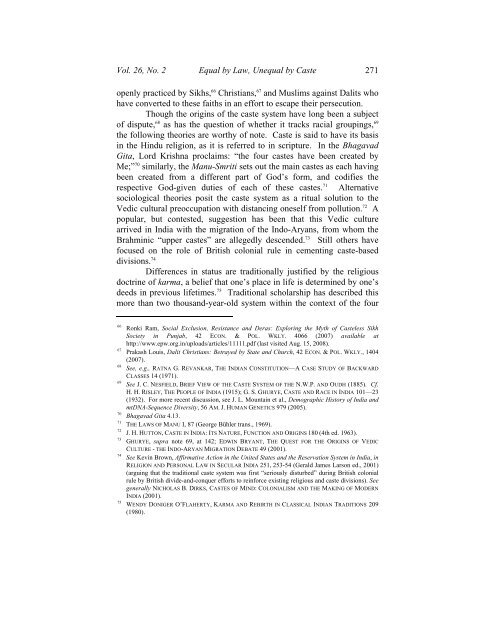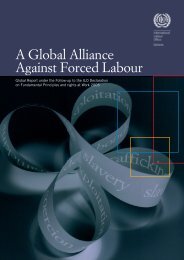equal by law, unequal by caste - International Dalit Solidarity Network
equal by law, unequal by caste - International Dalit Solidarity Network
equal by law, unequal by caste - International Dalit Solidarity Network
You also want an ePaper? Increase the reach of your titles
YUMPU automatically turns print PDFs into web optimized ePapers that Google loves.
Vol. 26, No. 2 Equal <strong>by</strong> Law, Un<strong>equal</strong> <strong>by</strong> Caste 271openly practiced <strong>by</strong> Sikhs, 66 Christians, 67 and Muslims against <strong>Dalit</strong>s whohave converted to these faiths in an effort to escape their persecution.Though the origins of the <strong>caste</strong> system have long been a subjectof dispute, 68 as has the question of whether it tracks racial groupings, 69the following theories are worthy of note. Caste is said to have its basisin the Hindu religion, as it is referred to in scripture. In the BhagavadGita, Lord Krishna proclaims: “the four <strong>caste</strong>s have been created <strong>by</strong>Me;” 70 similarly, the Manu-Smriti sets out the main <strong>caste</strong>s as each havingbeen created from a different part of God’s form, and codifies therespective God-given duties of each of these <strong>caste</strong>s. 71 Alternativesociological theories posit the <strong>caste</strong> system as a ritual solution to theVedic cultural preoccupation with distancing oneself from pollution. 72 Apopular, but contested, suggestion has been that this Vedic culturearrived in India with the migration of the Indo-Aryans, from whom theBrahminic “upper <strong>caste</strong>s” are allegedly descended. 73 Still others havefocused on the role of British colonial rule in cementing <strong>caste</strong>-baseddivisions. 74Differences in status are traditionally justified <strong>by</strong> the religiousdoctrine of karma, a belief that one’s place in life is determined <strong>by</strong> one’sdeeds in previous lifetimes. 75 Traditional scholarship has described thismore than two thousand-year-old system within the context of the four66676869707172737475Ronki Ram, Social Exclusion, Resistance and Deras: Exploring the Myth of Casteless SikhSociety in Punjab, 42 ECON. & POL. WKLY. 4066 (2007) available athttp://www.epw.org.in/uploads/articles/11111.pdf (last visited Aug. 15, 2008).Prakash Louis, <strong>Dalit</strong> Christians: Betrayed <strong>by</strong> State and Church, 42 ECON. & POL. WKLY., 1404(2007).See, e.g., RATNA G. REVANKAR, THE INDIAN CONSTITUTION—A CASE STUDY OF BACKWARDCLASSES 14 (1971).See J. C. NESFIELD, BRIEF VIEW OF THE CASTE SYSTEM OF THE N.W.P. AND OUDH (1885). Cf.H. H. RISLEY, THE PEOPLE OF INDIA (1915); G. S. GHURYE, CASTE AND RACE IN INDIA 101—23(1932). For more recent discussion, see J. L. Mountain et al., Demographic History of India andmtDNA-Sequence Diversity, 56 AM. J. HUMAN GENETICS 979 (2005).Bhagavad Gita 4.13.THE LAWS OF MANU I, 87 (George Bühler trans., 1969).J. H. HUTTON, CASTE IN INDIA: ITS NATURE, FUNCTION AND ORIGINS 180 (4th ed. 1963).GHURYE, supra note 69, at 142; EDWIN BRYANT, THE QUEST FOR THE ORIGINS OF VEDICCULTURE - THE INDO-ARYAN MIGRATION DEBATE 49 (2001).See Kevin Brown, Affirmative Action in the United States and the Reservation System in India, inRELIGION AND PERSONAL LAW IN SECULAR INDIA 251, 253-54 (Gerald James Larson ed., 2001)(arguing that the traditional <strong>caste</strong> system was first “seriously disturbed” during British colonialrule <strong>by</strong> British divide-and-conquer efforts to reinforce existing religious and <strong>caste</strong> divisions). Seegenerally NICHOLAS B. DIRKS, CASTES OF MIND: COLONIALISM AND THE MAKING OF MODERNINDIA (2001).WENDY DONIGER O’FLAHERTY, KARMA AND REBIRTH IN CLASSICAL INDIAN TRADITIONS 209(1980).
















